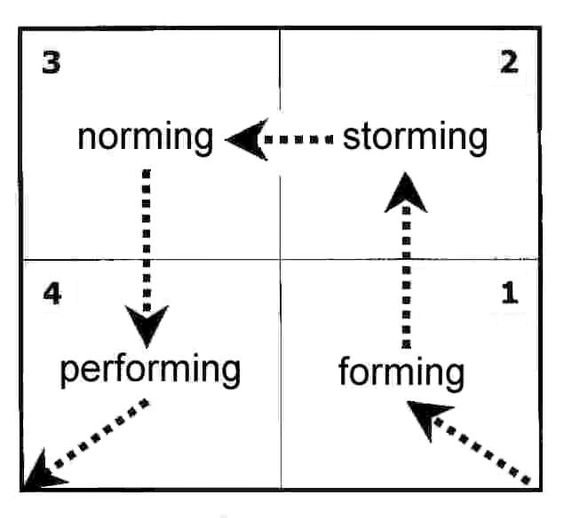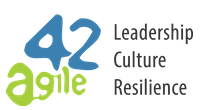
A game to explain the Tuckman model, Dr. Bruce Tuckman’s 4-stage model for teams.
Tuckman’s model
Dr. Bruce Tuckman’s 4-stage model of team development (forming/storming/norming/performing) is one the most commonly used and referenced team-building models in business today. Published in the 1960’s, Tuckman’s model demonstrates how, as teams develop skills, knowledge, and specific attitudes over time, their productivity also increases. Tuckman’s model suggests that, as these developments take place, the leader’s style should also change to reflect the growing maturity of the team. Like Blanchard’s situational leadership model, Tuckman’s suggests that the leader’s style should progress from being very directive, to coaching and supporting, to delegating.

The Exercise
Start by writing the four original phases of the Tuckman model on the flipchart (leaving room for drawing the J-curve from the Katzenbach and Smith model). You can initially say a bit about the history of the Tuckman model: Bruce Tuckman was hired by the US Navy in the early 1960s to research team behavior. He developed the four-stage model of Forming, Storming, Norming, and Performing. This is the original format. In 1977, he and Mary Ann Jensen extended the model with a fifth stage, Adjourning, which describes the phase of disassembling a team. We only consider the first four in this module.
Ask the participants to join you on the floor and make sure there is a lot of space for moving around.
Say that, first of all, you want to illustrate the Forming phase and give the participants the following instructions:
Forming (Attack & Defence): Secretly, without telling anyone, pick one person from the group as your enemy (person A) and another as your shield (person B). On my signal, position yourself so you always have your shield (B) between you and your enemy (A).
It is good facilitation practice to illustrate it with two people in the group. Also, note that when you have positioned yourself, and your persons A and B start moving around, you, of course, have to re-position yourself.
You will notice that the formation is unstable and the group is wandering randomly around. Stop them after a while and give them the following lecture:
In the Forming phase, the team is looking for answers more than questions: Who participates? What are we going to do? How shall we do it? and Who are we referring to? Here, the ScrumMaster or Agile Coach should help with the introduction of participants to one another and the clarification of basic terms, objectives, vision, and values. We are at the Shu-level, it is “wax on, wax off” (reference the Karate Kid movie). We give guidance and instructions instead of asking questions like: “What do you think?”.
Next is the Storming phase (Protect team member): With the two same people as before. Now you and your shield change roles. You are now shielding person B from person A. That means, always stand between your enemy and the one you are shielding.
Again, illustrate it by positioning yourself between the two persons you used before.
You will notice that the group is still unstable, and starts jostling each other at the center of the floor. Stop them after a while and give them the following lecture:
In the Storming phase, the team faces challenges in coordinating and resolving difficulties with regards to establishing a common understanding, roles, and procedures. Some of the members will be annoyed about other members interfering and having opinions about how they do their job and tasks (“I have always done it like this and I know it works when I do it like that. Now you are telling me to do it in another way!”). Some will start building alliances with other team members and so on. Here, the ScrumMaster or Agile Coach should work on conflict resolution/dissolution and start developingteam-specific common understandings of roles, routines, etc.
Next, the Norming phase (To be done in silence): Now try to keep an equal distance from the two other members. On my signal, you must always have the same distance from both person A and person B when you are moving around. If you experience me interfering with you, please just continue maintaining an equal distance from both person A and person B.
Again, illustrate this with the two persons you used previously. When they start moving around, have patience and wait for them to reach a stable situation, where all are standing still with equal distance to their person A and B.
While they are moving around, see if you can identify who most of them have chosen as either a person A or a person B. Who is the one who will impact the group the most if you force that person to move to another corner of the room?
When they have a stable situation, say: I am the head of your department and I have realized that one of my other teams faces challenges with their project. They need an expert to help them and that expert is you (point to the person you have identified as the person impacting the group the most). Continue: You, as the expert, must come with me and help the other team. The rest of you should just continue your work.
Take this person with you and, ideally, walk out the door with him/her. Notice that the rest of the group should re-position themselves and, in a very successful setup, some of them will actually leave the room with you, following the person you picked. You can stop and ask them: What are you doing? I just want this person to help me, you should continue doing your job!
Get everyone back to the room and give them the following lecture:
In the Norming phase, the team will start establishing a common understanding, roles, and procedures through self-assessment and agreements. A community will be established and each individual will begin to accommodate himself. What did you see when you found a stable situation? But then what happened when I did Drag-and-Drop management, taking the expert to the other team?
Have a discussion about the dysfunctional impact of removing the expert of the team and state that teams will become less mature whenever the team is changed. The manager might have solved a problem for the other team, but the manager also created a new problem for the team that lost the expert.
Also address that, in the Norming phase, the ScrumMaster or Agile coach should encourage the development of team-specific common understandings, roles, working behaviors, etc.
Finally, the Performing phase (Work together): Ask the whole class to form equilateral triangles as a team, meaning that each person must form a triangle with two other people.
It should go fast and you should notice them communicating with each other in order to finalize the task.
Discuss the characteristics of the performing phase: Now the team can primarily concentrate on getting the job done instead of procedures, cooperation, and organizing. The cooperation is working well and there is less talk about process and self-assessment.
Here, the ScrumMaster or Agile Coach should help encourage work performance through a focus on excellence, potentials, new targets, etc.
It is also important to mention that the ScrumMaster or Agile Coach must adjust the interaction with the team according to where they are.
- You direct more in the Forming phase.
- You are primarily solving conflicts in the Storming phase.
- Going through the Norming phase and the Performing phase, you are gradually moving towards a coaching approach, stating observations, asking powerful questions, and letting the team find their own solutions.
Time-Box: 15 minutes.
